#Qing Dynasty Artworks
Photo
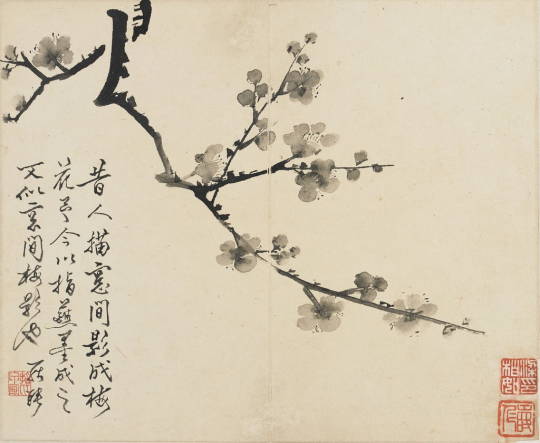
Landscapes, Flowers and Birds: Plum, Qing Dynasty, 1780 (ink on paper) by Luo Ping
#landscapes#flowers#birds#plum#qing dynasty#ink on paper#luo ping#asian#asian art#art#artist#artwork#paint#painting#ink#art gallery#branch#tree#blossom#chinese#china
51 notes
·
View notes
Text
Meanwhile, in Zhenjiang…
In my youth, before the European powers began carving out concessions in China, I was visiting the Qing imperial court and chanced to meet an itinerant Finnish artist, named Tom, who studied traditional painting under Shen Quan. When we parted, he gifted me this wonderful painting.
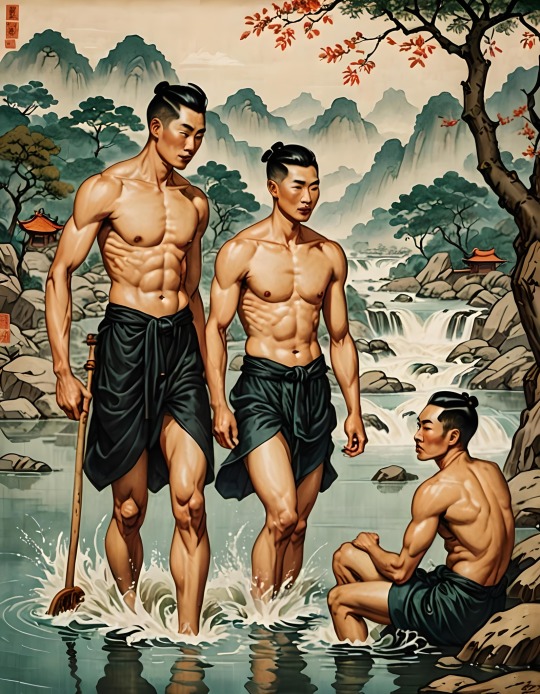
Crafted in NightCafe Studio using Stable Diffusion and Dreamshaper XL Lightning.
#ai art#stable diffusion#aiart#sdxl#stablediffusion#ai artwork#ai art community#qing dynasty#shen quan#china#men#bathers#landscape#river#painting#tom of finland#male beauty
10 notes
·
View notes
Text

Updated some old oc designs :) Might actually develop them now that I like how they look ajshsn
#art#digital art#my art#oc artwork#original character#original art#character design#art improvement#oc art#the colors took my forever cus i still dont understand color theory#the clothes also went from Qing dynasty to Ming dynasty lmao#they went back in time
16 notes
·
View notes
Photo
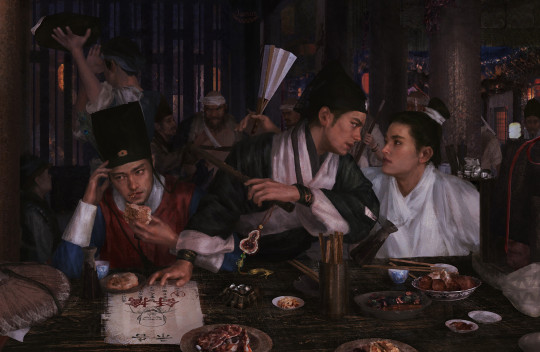
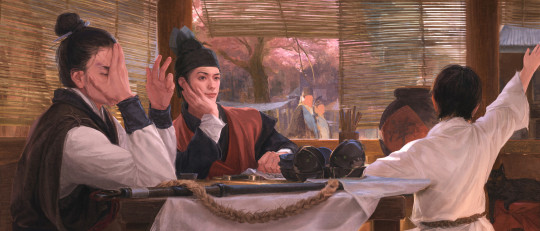
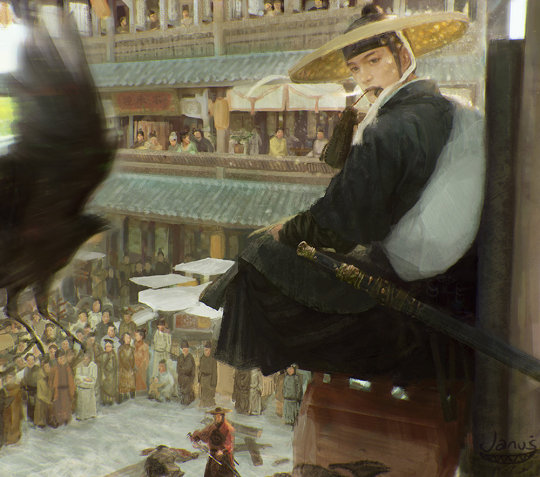
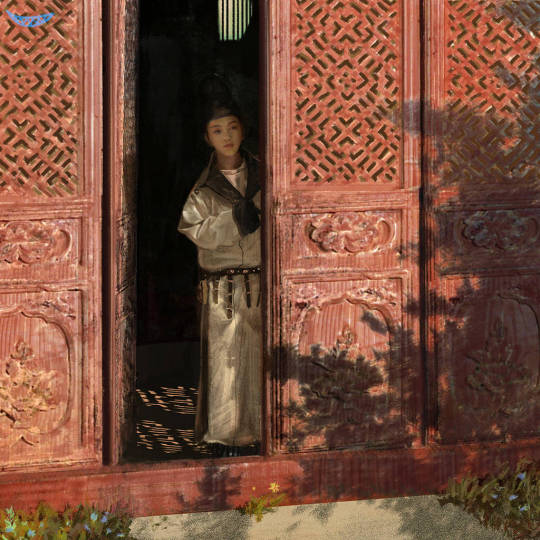

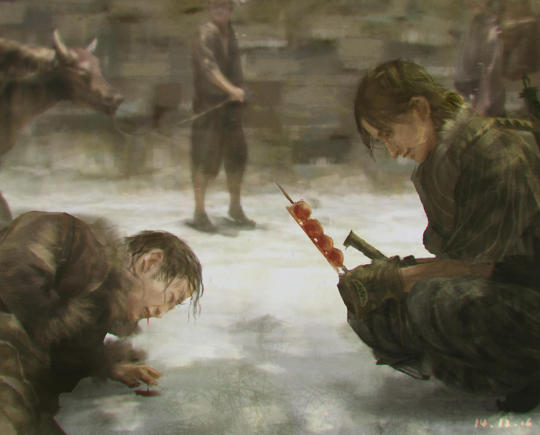

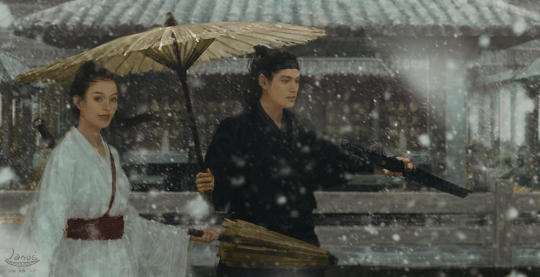

Jianghu fairy tales with a brush. Vivid scenes by Janus Liang.
I always appreciated the backstage hints and this engagement in the plot in such artworks.)
#Jianghu#Jian#wuxia#chinese painting#Ming Dynasty#Qing Dynasty#artwork#chinese art#ancient china#illustration#chinese martial arts#painting
11 notes
·
View notes
Text

anonymous artist, Qing dynasty 18th century.
#artwork#art#painting#oil painting#art history#museum#art museum#history#realism#art world#18th century#anonymous#anonymous art#qing dynasty
2 notes
·
View notes
Text


龚贤 - 金碧山水 by Gong Xian (Qing dynasty)
There's a special style in Chinese landscape painting called 青绿山水 (Qinglu Shanshui) which uses mineral dyes to complete the artwork. Those artworks have major green and blue colors. During Song Dynasty, artists and scholars added is 泥金 (made of glue and powdered gold or other metals) to the dyeing materials. These landscape paintings are 金碧山水 (Jinbi Shanshui).
7K notes
·
View notes
Note
You've poated Jade corn ornaments twice now (maybe more, and I've missed it). Why are they a thing? They seem to be really well done, and I had always viewed Jade as being a gem with cultural significance.
During the Ming and Qing dynasties in China it was popular to carve jade into vegetable- or fruit-shaped ornaments, the most famous artwork being the 翠玉白菜Jadeite Cabbage and 东坡肉形石Dongpo Meat-shaped Stone, 白菜baicai/cabbage is a common carving subject because of its resonance with '菜cài=财cái=wealth' in the Chinese context. Chinese call these ornaments 文玩wenwan in general, meaning fine collectible traditional handicrafts, especially suitable for playing and appreciating in the hand. I feel like the contemporary jade or other gemstone ornaments continues this tradition with further innovation. Young people prefer ornaments made in richer mineral materials and brighter colors (light colors are more popular), and the themes are also diverse, not limited to traditional ones. I guess in young peoples' aesthetic, the jade corn is lovely in shape and roasted corn is a popular street food in china. Other contemporary pieces that young people like to collect include various other shapes, such as jade rabbits, 貔貅pixiu(mythical creature that brings fortune and wards off evil), 龙long(chinese dragon), calabash, grape, fish, butterfly, crabs, flowers, guanyin, metteyya, the twelve shengxiao, and so on, some more traditional, some more contemporary. It's quite fun.
In addition, the Chinese believe that 玉yù/jade is spiritual(the Chinese word 玉yù actually refers to more than just jade, it can refer to jade-like stones in general but let's put it this way), so the Chinese have the habit of "nurturing jade", meaning that if you wear and play with your jade jewellery/ornaments by hand for a long time (the act of playing with it is called "盘pán"), it will become smoother and accumulate more lustre, bringing you a good energy field in daily life, thus you will have more luck. The Chinese also consider that if the jade ornament has been 开光kāi guāng (blessed by eminent 道士daoshi/daoist priest or blessed by eminent bhiksu or bhikkhunī/buddhist monks or nuns, usually with ceremonial process of chantting/intoning incantations), they will also help to protect you from mishaps and even disasters. Many Chinese women have the habit of wearing jade bracelets or red string weaved jade ornaments (jade bracelets are the type of smooth circular or beads bracelets).

翠玉白菜Jadeite Cabbage and 东坡肉形石Dongpo Meat-shaped Stone are as follows.
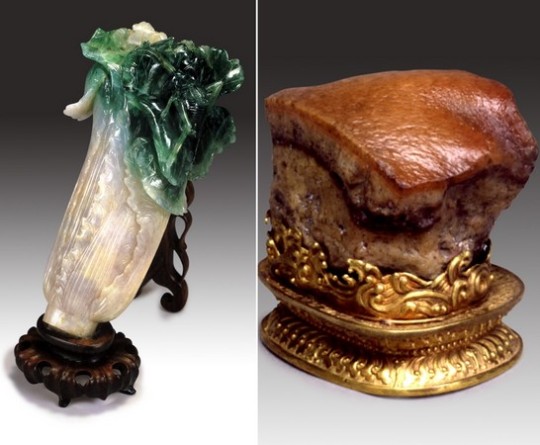
448 notes
·
View notes
Text
for modern AU fics - what chinese media did diaspora consume?
making this post because some of us in the diaspora server were having a chat about what Chinese media "Diaspora Chinese" watched in the 90's - 2000's (and even sooner than that) while not having access to satellite chinese media or streaming services - this is in the context of writing modern AU fics based off Chinese media/novels (so your main character's grandpa or uncle is not, in fact, watching an episode of Friends or Shortland Street or something as flavour text because sorry what the hell-)
We generally watched a lot of stuff on VCDs, including bootlegged and non-bootlegged movies, shows, anime/donghua. My household had a whole VCD album of this, and a lot of VCDs (even if they were pirated editions) would have a fancy hardcover box with a magnetic clasp and some artwork representing the show on it.
All of this is Mandarin - so not TVB stuff, because I'm from Northern China and I don't know any cantonese - but Canto friends, please feel free to add to the list! This is mostly stuff my parents liked to watch, or I liked to watch with them, with the exception of a few which I mainly watched with friends/cousins when I was maybe (in most cases) eleven/twelve years old onwards. This is a pretty personal list, meant to give people general idea of a possible "ballpark" of sorts, and by no means exhaustive.
Now, for the list of shows which I can confirm I had or someone I know had on VCD or some kind of offline media format lol (I'll try add release year stamps and links to the EN wikipedia where possible):
Period dramas (mostly Qing Dynasty stuff):
Huan Zhu Gege 还珠格格 (1998, April-) This is a classic, so many memes come from this show; hugely popular series, basically cemented Zhang Tie Lin's face as the face of the Qing Emperor for about a decade.
Tie Chi Tong Ya Ji Xiao Lan 铁齿铜牙纪晓岚 (2002-2010) - I loved this show as a kid and watched all four seasons on repeat with family... The "trio" in this show are well known and loved.
Amazing Detective Di Ren Jie / 神探狄仁杰 (2004) A very popular and addictive show.
Ok now the Big Four:
Romance of 3 kingdoms 1994 / 三国演义 (1994) - a classic that has had many remakes, my older cousin would play this on repeat...
Hong Lou Meng/红楼梦 (1987) - another classic with many remakes, but I think the most recognised by the public one is the 1987 one.
Journey to the West / 西游记 live action (1986) - I think the 1986 version of the live action is the most recognised one.
*Shui Hu Zhuan / 水浒传 (1998) - I am not too familliar with the live action of this one in my household tbh bc my mum doesn't like it lol (she keeps saying it's too depressing) but I'm sure it's up there with the rest of the big four, if anyone has an opinion on this one please let me know!
Modern setting shows:
My dad loved all the Sun Honglei (孙红雷 - actor name) stuff, iirc it was a lot of MinGuo period espionage stuff, your shanghai 1920's sxc aesthetic. This actor has been around since 1999? Qian Fu (潜伏)was very famous, and Ren Jian Zheng Dao Shi Cang Sang (人间正道是沧桑)。 These were around '08 and '09.
Chuang Guan Dong - 闯关东 (2008) (Baidu link, sorry - couldn't get an EN wikipedia one). This show was huge when it was airing, everyone was watching it. I was pretty young but even I watched it and got invested ... and I thought it was such an "old person" show at the time lmao.
Xiao Bing Zhang Ga / 小兵张嘎 (2004) (sorry, again Baidu link) - yo, anti-japanese war movies set between 1937-1945 were crazy popular - this is one of them and was very popular):
Donghua/Anime (all the stuff kid me watched and some which I didn't but were popular):
喜羊羊与灰太狼 (2005-)
Calabash Brothers / 葫芦兄弟 (1986-1987)
Black Cat Detective / Hei Mao Jing Zhang 黑猫警长 (1984-2010)
Lan Mao Tao Qi 3000 Wen 蓝蓝猫淘气3000问 AKA 蓝猫 (blue cat) (October 1999 - Present)
Legend of Ne Zha 哪吒传奇 (2003)
Journey to the West/Xi You Ji 西游记 This was truly the Donghua I grew up on from when I was a bb, the OP song and ED song are classic bangers all kids know.
Slam Dunk/ 灌篮高手 - People truly watched a lot of anime that may or may not have been terribly dubbed into mando (possibly canto too). Late 80s and 90s kids were all over this, and Dragon Ball, Crayon Shinchan (labixiaoxin).
Taiwanese Dramas:
This is mid-late 2000's, I would be remiss to not talk about the Taiwanese dramas of this era. Mike He, Rainie Yang, Wu Zun (amongst many, many others) were huge. Stuff like Dou Niu Yao Bu Yao, it started with a kiss, Hua Yang Shao Nv (Taiwanese version of Hana Kimi) were all pretty popular. Not sure if these shows all hold up in 2023, but boy were they popular at the time.
Note about CNY:
For CNY, people would try to tune into 春节联欢晚会 (the CCTV official CNY show) at that One Friend Who Had China Satellite TV's house. Zhao Ben Shan / 赵本山 was a comedy staple, and the show would often feature people from the music industry to perform. Eventually these people became more and more relevant to my gen and Jay Chou etc started appearing.
Last but not least Xian Jiaaaan 仙剑:
In 2005 I was all over 仙剑奇侠传 (Chinese Paladin), based off the video game. This show was crazy popular and probably sent me and a whole lot of other kids into Xianxia / Wuxia hell (and Hu Ge hell, and later I came back to love Liu Yifei). Thank you. The OST is a true banger.
#cnovel#mdzs#cdrama#chinese diaspora#danmei#not a lot of jinyong wuxia shows here so people who have opinions please chime in!#whew that was more than i thought#music could do with another post#but i dont know too much about my dads music i was just a 2000s cpop nerd#also this doesnt cover movies either#please no lan qiren watching friends#this breaks me out of my immersion immediately unless there was a specific reason why shufu is watching friends#not even sure how to tag this#late 2000s you could pretty much stream and download stuff i think i did that for bbjx when it came out#even tho my parents hated The Internet i managed#feel free to add more to this in a post or tags or whatever
143 notes
·
View notes
Text

The trouble with collecting merch is it’s difficult to stop once you start. This Jingsu enamel pin is by the prolific 长风万里, who is responsible for some of the most iconic NiF pins (check out the weidian store for a partial selection). Like many fan-made pins, it’s a re-rendering of a scene from canon, in this case episode 52 [x], where Jingsu look on as thunder and wind portend the storm brewing on the horizon after Princess Liyang has agreed to present Xie Yu’s confessed crimes at the Emperor’s banquet.
The pin emphasizes the storm in both design (bamboo leaves scattering in the wind) and name: 风雨同守, loosely enduring the tempest together. As for why the image has been transposed onto a tattered scroll, the pin maker said the inspiration came from rubbings/拓印 and elaborated some more:
Personally, I think of this as an excavated artwork (with the surface damaged in its old age) that was created out of Jingyan’s longing. As if Jingsu actually existed in history and will live on for a long, long time.
我自己把这个当做是一件出土的画作(年岁久远画面有所破损),是景琰怀念所做。就好像历史上真有他们的存在,靖苏真的来日方长。
Historically, rubbings not only create an impression of existing artwork but are themselves artworks that take skill and patience. The typical process starts with adhering paper to a stone carving, then ink is dabbed to the paper such that the flat surface takes on the color of the ink while carved areas remain white (here’s a process video). Collecting rubbings was a popular pastime of the literati, and rubbings of good calligraphy were especially in demand for study and appreciation, serving a similar purpose to block printing in allowing many people to see replicas of an original. The originals may have also come from a non-stone medium: some artworks originally on paper or fabric were replicated onto stone so that rubbings could be made and collected [x]. Nowadays, ancient rubbings are valuable artifacts, especially in cases where the carving has been lost.
The rubbing influence is very clear in the second version of the pin, here juxtaposed against one of its inspirations:
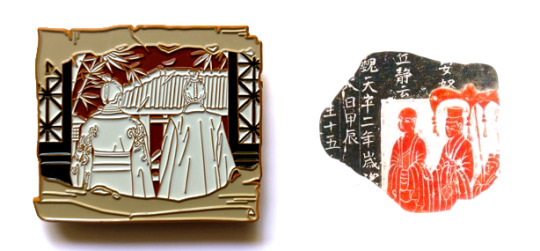
Though the text on the right rubbing says it’s from the Tianping Era of Eastern Wei, Year 2/魏天平二年 (535 CE), which is contemporaneous with the Liang dynasty that loosely inspired the fictional NiF Liang, I couldn’t find an actual historical artwork corresponding to this rubbing, and the mass antique market is flooded with fabrications (it’s also thoroughly possible I simply failed to find the original). But here’s a real fragment of a stone Buddhist votive tablet and its rubbing that’s now at the Art Museum of the Chinese University of Hong Kong [x]:

The text says that this was made in Tianping Era, Year 3, one year after the one above, and describes the building of a Buddhist pagoda in offering, which was a common practice at the time. This monochromatic rubbing style was also quite typical; though both black ink and red ink (cinnabar-based) rubbings existed separately, they were not really seen in combination in a single rubbing until much later. What is believed to be the only surviving book of bicolor rubbings before the modern era was made in the Qing dynasty around the 1800s and was itself a copy of a lost multicolor work from the same dynasty [x].
In this context of transference of art and meaning between mediums, it’s all too easy to imagine a backstory for this Jingsu scroll: first there was a stone carving, close enough to the actual scene that the artist must have worked from Jingyan’s memory of that day. Instead of the more common approach of carving the outline or the background, the artist decided to carve the foreground so the figures were sunken into the stone. And later, a rubbing was made and mounted onto a scroll, buried and excavated, then finally rendered from fiction to reality in the form of an enamel pin. Each creation is an act of remembering and reinventing, of placing yourself in the observer’s shoes, of stoking the flames of the original story—the fire burns on through metaphorical wood replaced over the centuries, its appearance ever-changing, its core not forgotten.

That’s enough of reading too much into things—I also like the pin on its own. One thing that 长风万里 does well is not just sell pins but also communicate the entire behind-the-scenes process with the QQ group, which is several months’ worth of iterations that I find at least as interesting as the final product. For this pin, you can trace through chat logs how the pin evolved all the way from the original concept sketch to the pieces of metal that fit in your hand (thanks to 长风万里 for letting me share the draft versions here):

Once the pin maker comes up with an idea and decides to go for it, the initial sketch is given to the commissioned artist (this pin was drawn by Forwrite, on weibo and lofter) along with reference images. The artist turns these into a line drawing following the design rules of enamel pins (each block of solid color should be fully enclosed by lines, for example). Some artists will color in the line art while other pin creators commission only the line art and fill in the colors themselves. The final colors are limited to the available palette at the factory chosen to make the pins, and once the color vector art is handed to the pin factory along with instructions on detailing and finishes, the physical manufacturing process begins in earnest (this could be the subject of its own long post).
You may have noticed that there are some color changes from the vector design to the physical pins, most notably the sky in the top pin. This came about as a serendipitous accident where the factory colored the sky of the sample pin dark blue instead of the requested sunset yellow, but the pin buyers active in the group chat liked the dark blue enough that it was kept as the final color. The light grayish blue variant ended up being chosen for the backing card/背卡 instead:

Though backing cards are nominally named for their purpose in supporting the pin, practically no one sticks their pins through these cards in Chinese fandom; instead, collectors generally buy cases and books to keep each piece in pristine condition. And so unlike utilitarian cards that are meant to serve as a background to the pin, fully designed backing cards that stand on their own are very much a thing. The card also adds back in the iconic Jingsu lines that were in the original concept sketch, I want to choose you, Your Highness Prince Jing/我想选你靖王殿下 from Mei Changsu and Sir and I are as one person/先生与我如同一人 from Jingyan.
And now for the last part of the merch package that comes with the pin: the wooden piece on the left is an inscribed bamboo name slip/名刺 meant to resemble what MCS might have presented Jingyan when he visited his manor in episode 9 [x]. This was a preorder bonus to encourage buyers to get on board early, since the upfront costs to commission the artist and get a sample made at the factory are a significant portion of the overall costs (if not enough people preorder, the pin is canceled and the payment refunded, and the pin maker has to take the loss of at least the artist’s fees).
Name slips were the ancient analogs to modern business cards and an important tool of connection building in the ancient bureaucracy. The tradition of presenting a slip before you visit someone’s residence, especially if you’re lower in status than the person you’re visiting, persisted for many dynasties while the form of the slip evolved over time. Even though the visitation slip in canon appeared to be a bound paper booklet, folded books wouldn’t appear until the Tang dynasty—though paper was invented in the Han dynasty, it took time for the manufacturing process to improve sufficiently for a fundamental shift in writing mediums. Bamboo slips were what they would have used in the real Liang dynasty (plus, the modern-day replica is objectively great merch that can be used as a bookmark/fidget stick/cosplay prop/whatever else you can think of).
Slips from around the NiF time period generally stated some combination of your given name/名, your courtesy name/字, the region you’re from, and some boilerplate deferential language. Here are two real ones from Huang Chao/黄朝 and Zhu Ran/朱然 of the Three Kingdoms period next to MCS’s, with the meaning of some phrases listed in parentheses after the literal translation (using two of MCS’s names is a good solution for the lack of courtesy names in canon):
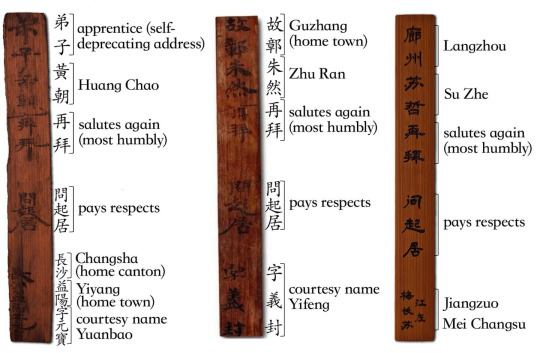
To balance out all the white background product photography, I’ll close with some texture shots:
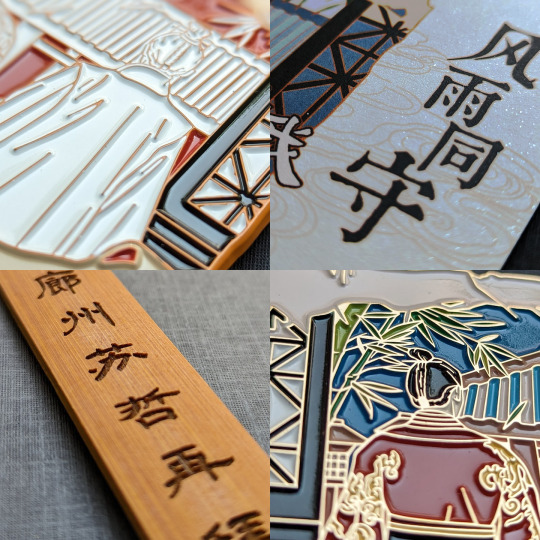
#cost for everything was ¥90 or about $13#overseas shipping not included#先生与我,如同一人#chinese fandom#nirvana in fire#琅琊榜#merch review#long post
76 notes
·
View notes
Note
Hi! I have a question about... sleeves.
I am looking at designing what is essentially, in-universe, a stage costume but still want it to be at least a tiny bit historically accurate.
It would be a late Jiaqing era (~1810s) inspired aoqun, with a mamianqun (specifically a fengweiqun) and possssssibly a cloud collar to form an ensemble that's intended to portray a fenghuang (thus the skirt lol) and probably somewhat fancy on account of the celestial nature.
I know that sleeves in China have historically often been either long or Extremely Long especially for noblewomen but I was wondering about how that extends (ha) to the Jiaqing era of the Qing Dynasty.
I see, for example, Ming-style clothing that has these very long, drapey sleeves such as these: https://ziseviolet.tumblr.com/post/702949049252364289/ (though I know the Ming would have ended like 200 years before the 1810s but I also know you've mentioned that a lot of Ming fashion continued into the Qing for a while) I like the way they look on account of being very flowy which seems fitting for a bird-themed outfit where the person wearing it would be essentially portraying the fenghuang onstage, so long flowing gauzy shapes seem very fitting, but I'm not sure how much flexibility there is for late Qing sleeve styles or how much creative license goes into those types of XYZ dynasty-inspired outfits.
Relatedly I'm curious how common sheer, soft-draped fabric like that would have been in the early 1800s. I know it was very popular in certain eras, and of course in western fashion at the time Regency clothing used a lot of soft loose shapes, so I'd be interested to know if that kind of thing was particularly common in the 1810s in China or not.
I think sleeves started getting much shorter and more tight fitting in the 18th century, but wide sleeves saw something of a revival by the turn of the 19th. In the Jiaqing era, sleeves could be described as wide but not necessarily long, and usually had folded cuffs that reduced the length. I haven't read about actual garments from that period so I can't tell you concretely, but that appears to be the case from artworks.
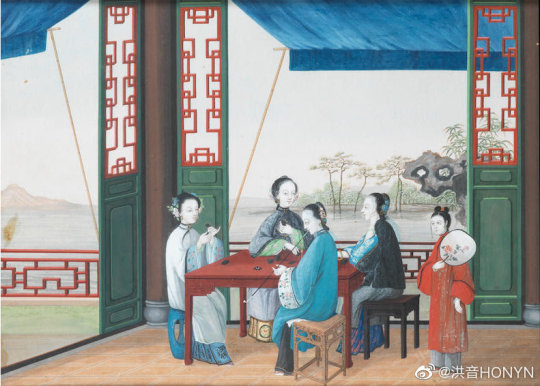
The blogger 盥薇 did a recreation of Jiaqing era dress based on export paintings, in her interpretation the sleeves are also still a little too long to be entirely practical but definitely not as long and drape-y as that in earlier centuries. This outfit might work as a reference for your costume, since it also features a cloud collar? (on a side note, the comment section of this video gives me psychic damage, please don't look)
About sheer, soft fabrics, yes they were indeed very popular around this time, and had been since the late Ming. Sheer clothes were usually meant for lounging around the house in warm weather and not worn outside, and sometimes you see women represented as forgoing underwear altogether. I'm not sure whether that's an artistic embellishment, but it does feel feasible given the domestic setting.
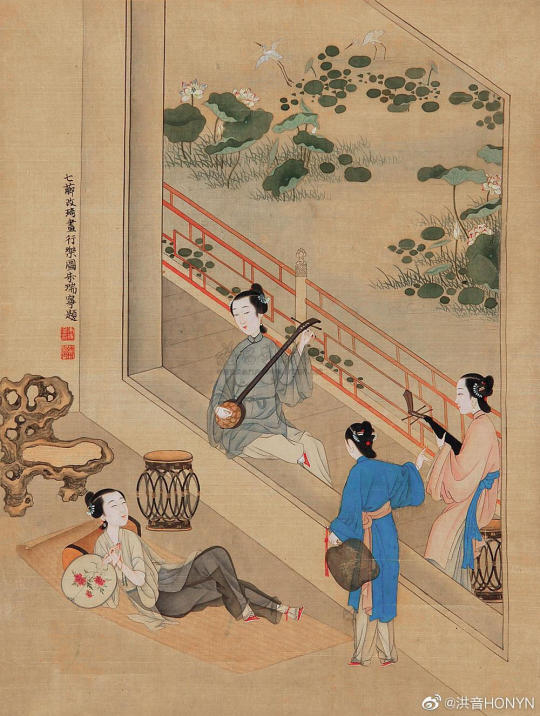

I explained in this post that the cliche of 'late Ming fashion continuing into the Qing' only actually applies to the 1650s. So the Jiaqing era, being in the early 19th century, has nothing to do with the Ming.
62 notes
·
View notes
Text
Hi Producer (正好遇见你) Infodump
Disclaimer: I have no idea about the accuracy of the information shared in the drama, I'm merely transcribing for future reference purposes. Proceed with caution!
.
Ep 1: Filigree Inlay

One of Eight Beijing Imperial Handicrafts, it's a traditional Chinese craft to deal with fine gold that has been passed down for over 2000 years. It originated from metal inlay of bronze casting technology as early as in pre-Imperial China. It dates far back to Spring and Autumn period and Warring States period, peaking in Ming and Qing dynasties with exquisite craftsmanship, aesthetic pursuit and sumptuous styles.
It uses gold threads and slices to decorate utilitarian objects such as bronzeware and weapons. With the development in the Sui, Tang, Song and Yuan dynasties, Filigree Inlay was increasingly applied in jewellery making.


.
The terms Filigree Inlay refers to weaving gold thread into jewel and inlaying with different jewels, starting with Thread Drawing, Shaping, Laying and then Filling.
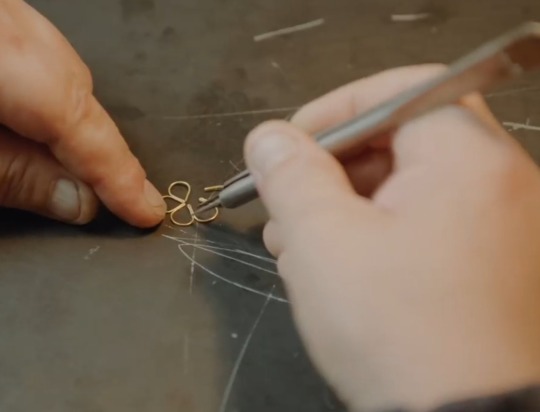

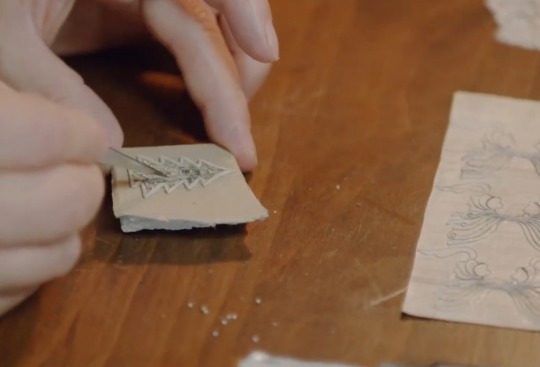
.
Gold Chalice of Eternal Stability

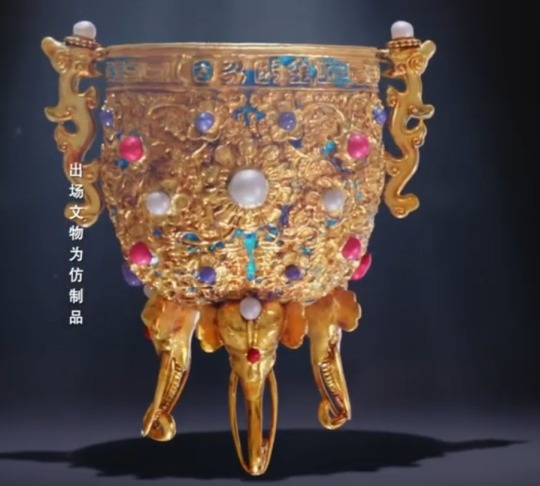
In the second year of Jiaqing, it was made in a workshop of the Internal Affairs Department of the Qing Dynasty. Carved with Baoxing flower patterns, with pearls, rubies and sapphires on the stamens. On every New Year's eve, the court would hold Kaibi ceremony to celebrate children's first day at school. This was the drinking vessel for emperor's praying.
.
Ming Dynasty Empress's Crown

Inlaid with thousands of pearls and hundreds of natural gems. Besides Filigree Inlay, Tian-tsui craft was also used in a complicated pattern.
.
Ming Dynasty Gold Thread Imperial Crown with Wings
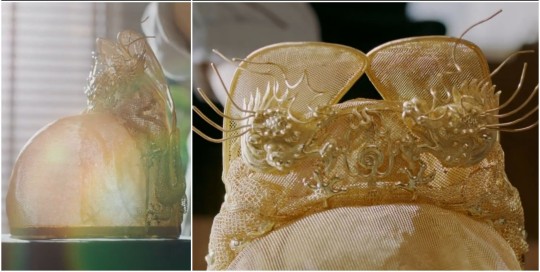
Unearthed from Emperor Wanli's tomb and now stored in Dingling museum, all the weaved parts have no joints or fractures to be seen. The remarkable consistency makes it the representative artwork of Filigree Inlay craft. 518 gold threads were used in the original work with the thinnest threads being less than 0.2 mm wide, many masters attempted to replicate it but with a much higher numbers of threads.
.
More Hi Producer Posts
37 notes
·
View notes
Text
CPN: BoXiao and Bamboo 🎋
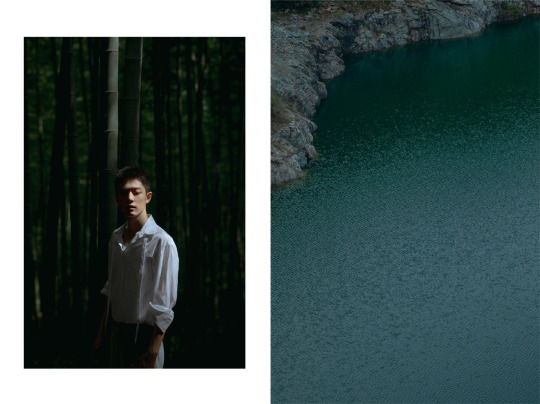
Another symbol that is tied to our boys but more so with Xiao Zhan. We have a couple of these things that we associate with them and this is an effort to try and make a post for each one. from stars, little prince, spongebob, moon, spiderman and now this.
-ˋˏ ༻❁༺ ˎˊ-
In traditional Chinese culture, bamboo (竹 zhú), along with plum blossoms (梅 méi), orchids (兰 lán), and chrysanthemums (菊 jú) collectively form a group called the Four Gentlemen. Each member of the group was used to symbolize some aspect of the character of an ideal person in traditional Chinese culture.
Certain behaviors and character traits are traditionally associated with each of these plants. In the case of the bamboo, its strength lies in its grace — it is tranquil, flexible, humble and simplistic, and an emblem of modesty and mental strength. Its deep roots denote steadiness. ( source )
Well that description sounds a lot like WYB or XZ if I ever did read one. It is a perfect way to explain to someone what these two are like as people and why they work so well together. Let’s start with the sweetest connection we have with it. In one of the BTS released, XZ was seen describing WYB as a Bamboo:

We know XZ likes to tease WYB about his face being so small and the fact that he ( XZ ) cannot compare to that. They are just so comfortable around each other and why is XZ observing him so much that he is able to make that kind of comparison? I also find that when XZ does this, he describes WYB as someone who is almost unreal. XZ speaks about him like he is a friend/fan and really says the truth whether WYB takes that as him just teasing him or not. At that time, they called it rainbow farting but when it comes to them, it’s not exaggerated. It’s the truth.
• In this other BTS, XZ calls his hairstyle as a wealthy bamboo. Then here, you can see him pole dancing lol and trying to catch Web’s attention.
• XZ once posted a meme of a bamboo rat and he went on hot search because of it. He mentioned that he liked it because it looks helpless and needed to be held. Months before that, WYB held a bamboo rat for TTXS. What a coincidence. Another one is them having the same bamboo background on their photos released on the same day. WYB’s is an Ad tho.

• I like this one, photo of a scenery with bamboos in it. I wish WYB would also share his photos 🙃

• and well this ever popular piece of fandom candy, XZ’s post below with a bamboo emoji in it. @twolonesomestars explains the meaning of it over here ( go to the post-japan trip section ) . Also the song he is supposedly referencing, summer’s wind has been analyzed by @jcisthebestfightme here. 🤍 If you’ve seen those photos of them on the rooftop and with the bamboo in view, this emoji use makes more sense too. I feel like they both have good memories of that night and everything about it.
+ Web playing with the Bamboo toy ( in TTXS ) that looked like what A’yuan was playing with in The Untamed 🥲

-ˋˏ ༻❁༺ ˎˊ-
As individuals, well, WYB loves to watch a channel dedicated to watching pandas and one of their activity is ofc eating bamboo. Also this photoshoot for his Bio-e fanmeet. Yes, the same event where he said that the older a man gets, the more handsome they are. 😏 and that event was close to XZ’s birthday - 9/30/2020. Finally, this photoshoot video from YBO that featured him amongst bamboos.
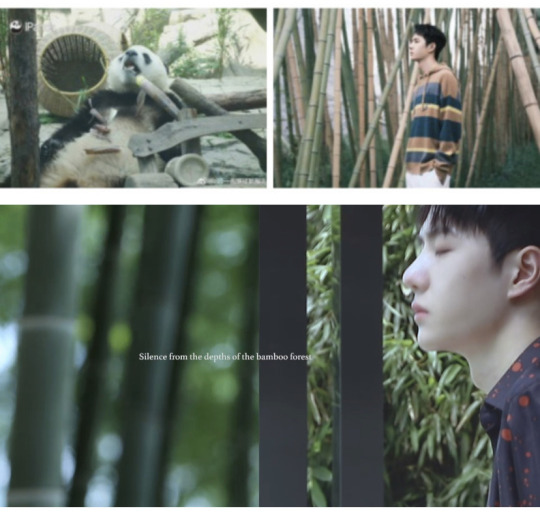
Now for XZ, he loves to pose with it too and the most notable one is his 29th birthday photoshoot 😎 as well as his most recent one. He also made an artwork that incorporated bamboo shoots in it.
We can’t forget WWX’s bamboo flute that XZ practiced irl and his most recent advertisements incorporating Bamboos. 🎋
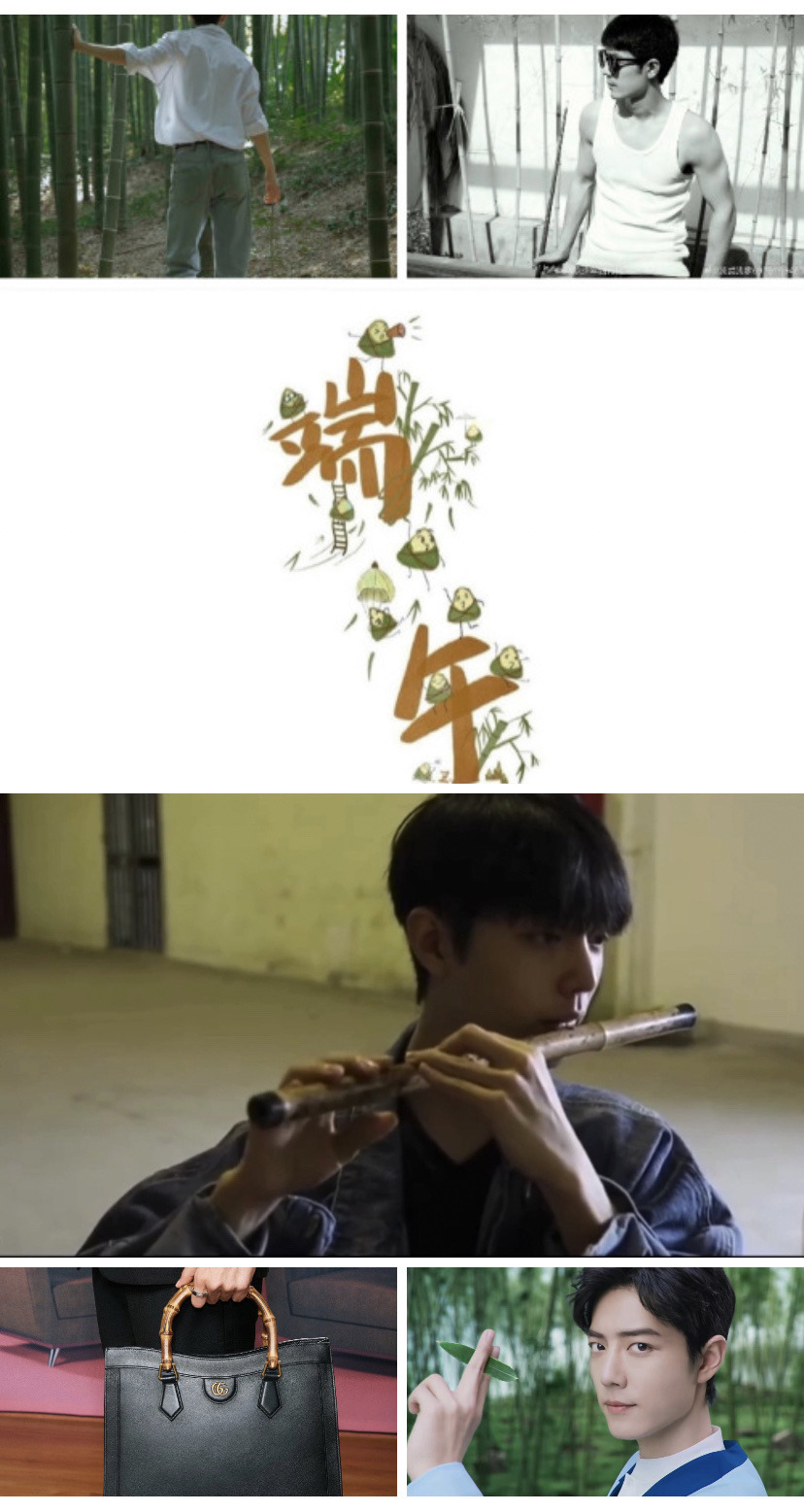
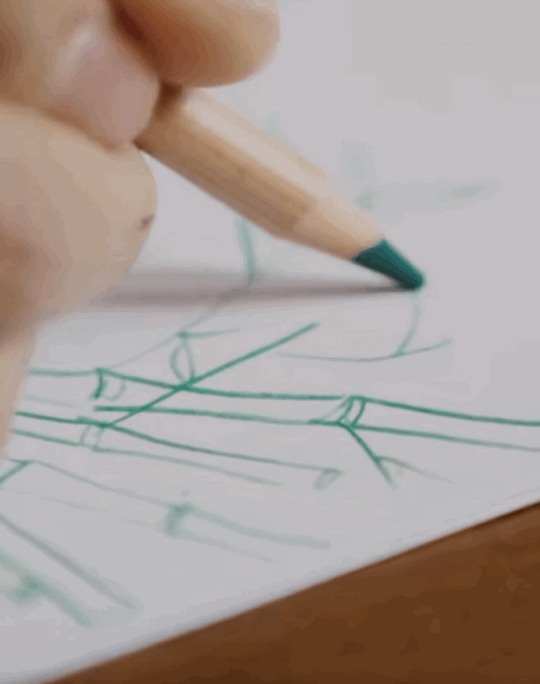

However the most important connection for XZ would have to be the song Bamboo in the Rock! 🎶
youtube
"Bamboo and Rock" is a seven- character quatrain created by Zheng Xie , a calligrapher and painter in the Qing Dynasty . This is an inscribed poem . The first two sentences praise the inner spirit of Jinzhu, which is rooted in the broken rock, fully expressing the tenacious vitality and fortitude of Jinzhu. The last two sentences further describe the harsh objective environment for the tempering and testing of the bamboo. No matter the wind and rain, despite the frost, the cold, the snow, the green bamboo still stands proudly.
parts of the actual song that I like and think relates to XZ are :
The thousands of hardship only bring about greater fortitude
Never relenting to winds from any direction
;
Never questioning its path
Irregardless of the sweet or the bitter
The reason why XZ sings this so well is probably because he understand the meaning of the song and the importance of having this particular characteristic of a Bamboo. He was performing this before all the 2020 disaster but he had a couple of experiences even before that were he’d gone through hardships and he remained firm. Even in his interviews, he makes it clear that he is someone who is not afraid of hardships because he knows it’s necessary. What is important to him is that he learns from it and that he continues on to reach his goals. 🤍
- END. Have a good weekend everyone! 🥰
#yizhan#bjyx#all of this is cpn#if there is a symbol you want me to talk about feel free to drop a reply here but no promises
75 notes
·
View notes
Text
My thoughts on Shang Simla
Thanks @thebleedingwoodland for tagging me in their posts here and here. Unfortunately I don't have much time atm, probably can't contribute much to the discussion. I'll try my best to explain my thoughts in the easiest and quickest way.
First, I never held much expectation for EA. Shang Simla is more like a friendly gesture to include Asian/Oriental cultures into Sims3 world. However, I never regard Shang Simla as a Chinese world, let alone any specific period. The minute I saw the torii ⛩️ とりい icon, as a Taiwanese visiting Japan many times, I knew Shang Simla would be a hybrid of most ancient (North East) Asian cultures even before sending my sims there. However, I don't think people back in 2009 had such high awareness or recognition for other cultures as we do today. They simply projected their impressions for the eastern world onto Shang Simla. So I would rather take this as a chance to introduce the right knowledge to simmers from other parts of the world.
What EA tried to present in Shang Simla is an ancient world, so honestly I don't blame them to provide the braid hairstyle from Qing dynasty. Yes, it is a symbol of repression, but it is also a historical fact. That's what people during that period of time would look like.
As for the outfit, honestly I think it's too much to ask, considering its 4000 year-long history and all the complicated details.

Yep, and that just covers the most basic types, there are numerous variations based on the occasion/age/social status/occupation...etc.
If you're wondering where those fancy outfits you saw on TV drama or games are, I would say they belong to the fantasy genre, like:
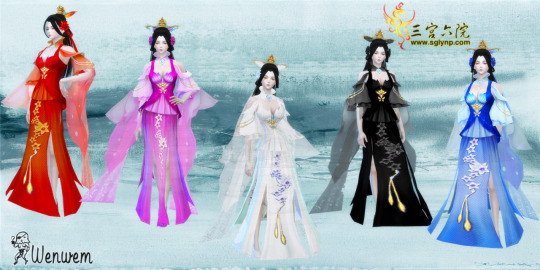
Note: for illustration only.
If you want to create a sims3 story with solid historical background, not fantasy or fictional, DON'T use these sources as your reference. Try googling artworks from that period, or related historical drama, those authentic ones.
Also, it's really important to notice the difference between Hanfu 漢服, Wafuku わふく and Hanbok한복. I'm no expert at these fields so I would only provide here the most basic types to give you a rough idea:
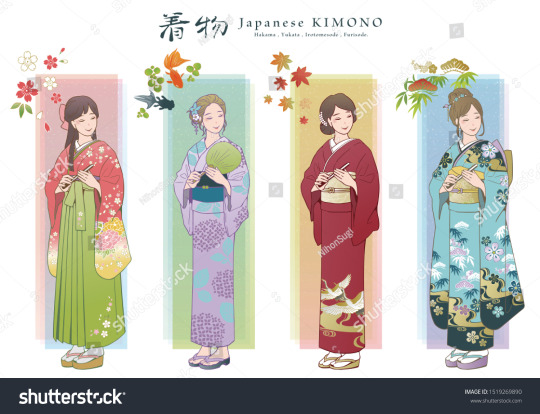

Ts3 CC creators I recommend include but not limit to:
Chinese: M&T 模拟人生单纯蛋糕店(M&T SimsCakeStore)/ 清霜童子@qingshuangtongzi
Japanese: kewai-dou / @m0m0-ka / @murfeelee / noiranddarksims
Korean: @amethyst-sims / ghostsyj
As for the martial arts outfit, the difference lies more on the sport events than nationality since there are corresponding uniforms now. For instance:
top to bottom:
Judo柔道 / Karate空手道 / Taekwondo 태권도 / Tai Chi 太極 /
Kung fu 功夫裝


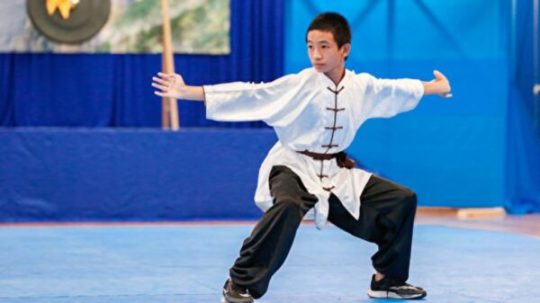
Of course, the sleeve-less kungfu clothes EA provided is a big no-no, a modernized version apparently.

Last but not least, during the ancient period, Chinese culture had great influence over the neighboring countries including Korea and Japan. That's why you may find it very difficult to tell which from which sometimes. Hope the illustrations above can help.
To be honest, I rarely let my sims visit Shang Simla. It's a weird world to me. Too much nonsense I'm afraid. Most of the time, I tend to build my own version, with specific period and custom content to make it more authentic and realistic.
Oh and DRAGON! Almost forgot. I think this is simply because THERE ARE TWO KINDS of DRAGON. One spits fire while the other controls the rain, basically two different species I believe :D
Western dragon VS Eastern dragon

Gonna stop right here before making this post too long to read. Let me know if there's any questions. 😘💜
*Correction- Shang Simla is supposed to be a modern Chinese world, not an ancient one as I previously thought. I don't think of it as a modern world probably because, as we all know, modern life for Chinese people are not that different from the western one. In fact, Shang Simla should look much more westernized/modernized to reflect reality, even for a rural area. Besides, in the modern times only farmers wear bamboo hats. I can tell which hanfu style implies which period easily but I just can't really identify what period Shang Simla should belong to. To me, it's just a modern world with some randomly chosen Chinese / Asian / oriental elements.
44 notes
·
View notes
Text
"Kippe" by Ai Weiwei (2006)

5 Facts About Artist Ai Weiwei and his work "Kippe"(2006)
Ai Weiwei is an activist.
Ai Weiwei was imprisoned for tax evasion.
Ai Weiwei's father was a renowned poet.
Ai Weiwei stands for human rights.
In German, the word "Kippe" means "the act of mounting the parallel bars."
The way I thought about the artwork changed from the first time I looked at it because I got more insight into who Ai Weiwei is and why he made this piece. Before I saw it as a bunch of wood pieced together tightly with what looks like a few other things as well. Now, understanding he was a gymnast himself and the "few other things" were parallel iron gymnastics bars and the wood being from the Qing Dynasty Temples, the artwork has more meaning to me. After reading this information and analyzing the photo of the art more, I can now see the metal gymnastics bars and the wood piled up, almost in the way, and blocking the bars off from my point of view.
2 notes
·
View notes
Text


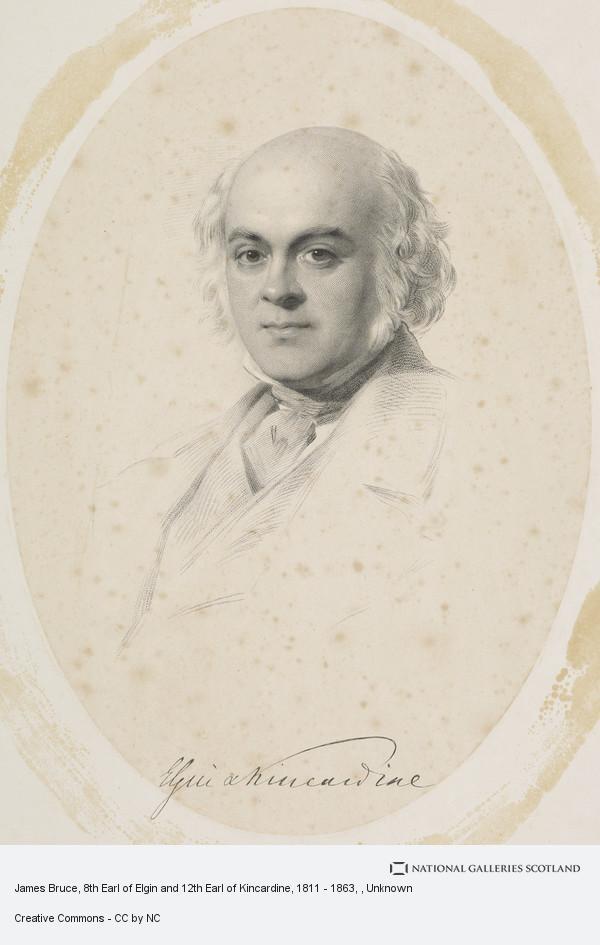
On July 20th 1811 James Bruce, the 8th Lord Elgin, Scottish Liberal statesman and diplomat, was born.
Another figure in our history that we should hang our heads in shame about, we can’t pretend that some of our nobility, like Bruce were part of an empire which inflicted much harm upon the world.
As a student at Eton and Oxford, Elgin displayed the brilliance that sparked his later reputation as an inspired orator, cultured humanist and judicious administrator.
He was appointed the governor of Jamaica then the governor general of Canada, Elgin was then appointed High Commissioner and Plenipotentiary in China where he oversaw the second opium war and unequal treaties. Lastly he became the first viceroy in India and in 1863 he died of a heart attack.
He is known for his roles in administrating the empire acting as governor in Jamaica and Canada as well as viceroy in India however he is held in infamy by the world for his actions in the second opium war.
The Chinese Qing dynasty’s officials had tortured 20 Europeans and Indians to death and so Elgin in retaliation ordered the destruction of the Summer Palace, just outside Beijing, an architectural wonder with immeasurable collections of artworks and historic antiques, inflicting invaluable loss of cultural heritage.
When the Qing Empire resisted, concerned about the effects of drug-addiction upon its people, the eighth Lord Elgin led the bombardment of Canton, to great loss of life. The Summer Palace was set aflame by 3,500 British troops and burned for three days. Some three hundred remaining eunuchs and palace maids, who had hidden themselves from the soldiers, perished with the burnt palace buildings.
Priceless cultural treasures, including fine porcelain, gold, jewels and statuary were carted off by the soldiers, the choicest artefacts being reserved for the eighth Lord Elgin, including bronze vessels prized locally for cooking and burial in tombs dating back to the Shang dynasty and were up to three millennia in age.
Subsequently, he submitted the Qing dynasty to the unequal treaty of the Convention of Peking, adding Kowloon Peninsula to the British crown colony of Hong Kong.
Bruce’s father, the 7th Earl is himself a controversial figure, he is the man that took the Parthenon Marbles, a collection o.f Classical Greek marble sculptures that have become known as The Elgin Marble.
6 notes
·
View notes
Text

MWW Artwork of the Day (8/26/23)
Qing Dynasty artist (fl. 19th c.)
Snuff Bottle (19th c.)
Molded & enamelled porcelain, 7 cm. high
The British Museum, London (Mrs. E.G. Gordon Bequest)
Snuff bottles were used by the Chinese, Mongolians during the Qing Dynasty to contain powdered tobacco. Smoking tobacco was illegal during the Qing Dynasty, but the use of snuff was allowed because the Chinese considered snuff to be a remedy for common illnesses such as colds, headaches and stomach disorders. Therefore, snuff was carried in a small bottle like other medicines. The snuff bottle replaced the snuff box used by Europeans. Snuff bottles soon became an object of beauty and a way to represent status and wealth.
2 notes
·
View notes